door lock MERCEDES-BENZ S-CLASS CABRIOLET 2018 User Guide
[x] Cancel search | Manufacturer: MERCEDES-BENZ, Model Year: 2018, Model line: S-CLASS CABRIOLET, Model: MERCEDES-BENZ S-CLASS CABRIOLET 2018Pages: 502, PDF Size: 6.27 MB
Page 81 of 502
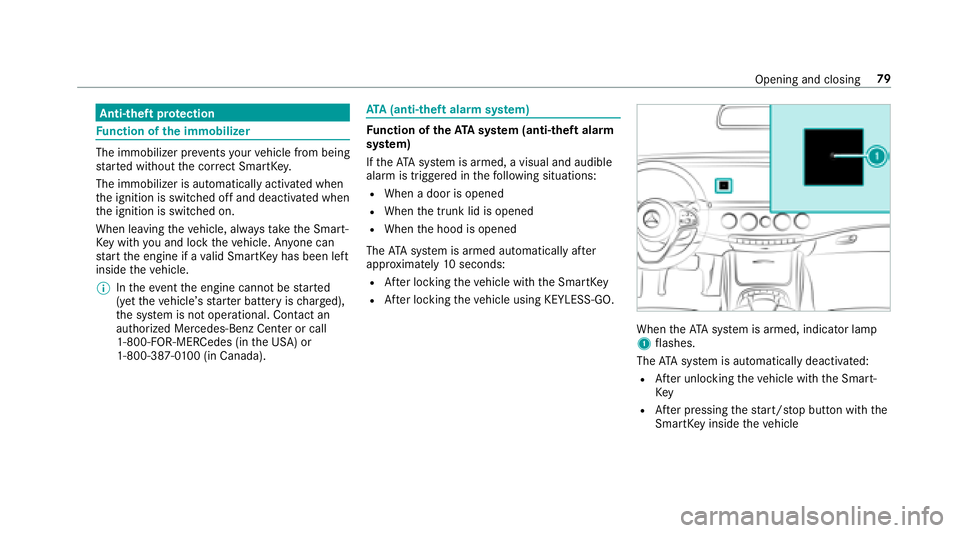
Anti-theft protection
Fu nction of the immobilizer
The immobilizer pr events your vehicle from being
st ar ted without the cor rect SmartK ey.
The immobilizer is automatically activated when
th e ignition is switched off and deactivated when
th e ignition is switched on.
When leaving theve hicle, alw aysta ke the Smart‐
Ke ywit hyo u and lock theve hicle. An yone can
st art the engine if a valid SmartK eyhas been left
inside theve hicle.
% Intheeve ntthe engine cannot bestar ted
(y et theve hicle ’sstar ter battery is charge d),
th e sy stem is not operational. Contact an
authorized Mercedes-Benz Center or call
1-800-FO R-MERCedes (in the USA) or
1-800-387-0 100 (in Canada).
ATA (anti-theft alarm system)
Fu nction of theATA system (anti-theft ala rm
sy stem)
If th eATA system is armed, a visual and audible
alarm is triggered in thefo llowing situations:
RWhen a door is opened
RWhen the trunk lid is opened
RWhen the hood is opened
The ATA sy stem is armed automatically af ter
appr oximately 10seconds:
RAfter locking theve hicle with the SmartK ey
RAfter locking theve hicle using KEYLESS-GO.
When theATA system is armed, indicator lamp
1 flashes.
The ATA sy stem is automatically deactivated:
RAf ter unlocking theve hicle with the Smart‐
Ke y
RAfter pressing thest art/ stop button with the
SmartK eyinside theve hicle
Opening and closing 79
Page 82 of 502
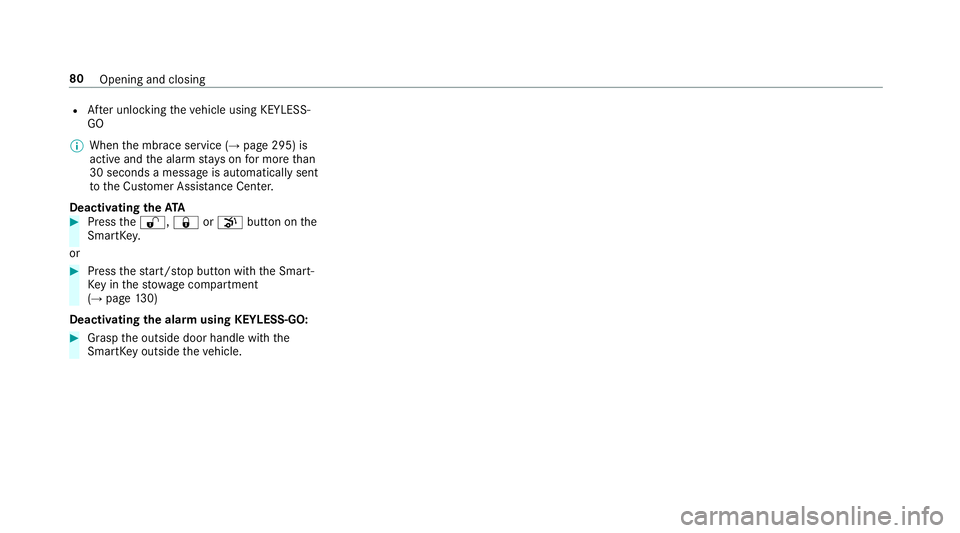
RAfter unlocking theve hicle using KEYLESS-
GO
% When the mbrace service (
→page 295) is
active and the alarm stay s on for more than
30 seconds a message is automatically sent
to the Cus tomer Assis tance Center.
Deacti vating the ATA
#Pressthe%, &orp button on the
SmartK ey.
or
#Press thest art/ stop button with the Smart‐
Ke yin thestow age compartment
(
→page 130)
Deactivating the ala rmusing KEYLESS-GO:
#Grasp the outside door handle with the
SmartK eyoutside theve hicle.
80
Opening and closing
Page 94 of 502
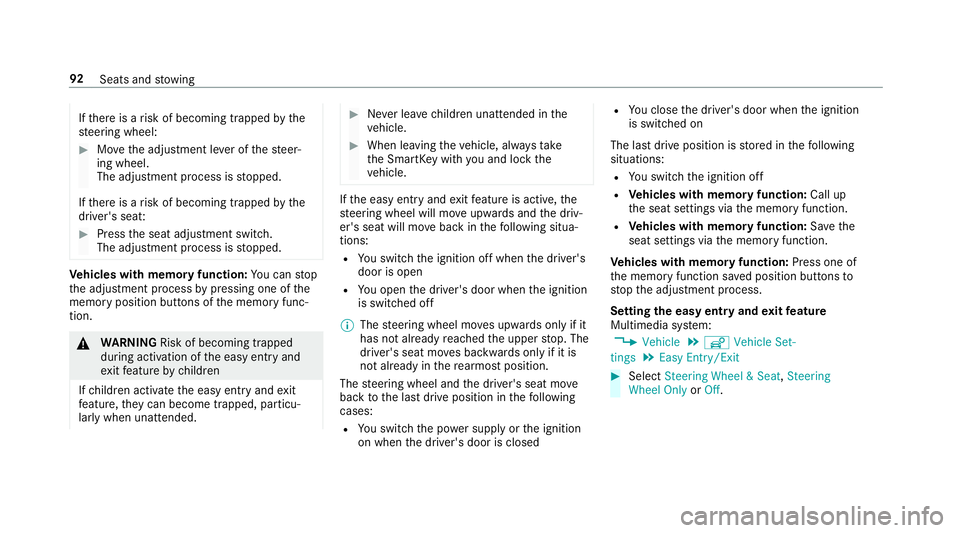
Ifth ere is a risk of becoming trapped bythe
st eering wheel:
#Mo vethe adjustment le ver of thesteer‐
ing wheel.
The adjustment process is stopped.
If th ere is a risk of becoming trapped bythe
driver's seat:
#Press the seat adjustment switch.
The adjustment process is stopped.
Ve hicles with memory function: You can stop
th e adjustment process bypressing one of the
memory position buttons of the memory func‐
tion.
& WARNING Risk of becoming trapped
duri ng acti vation of the easy ent ryand
ex itfeature bychildren
If ch ildren activate the easy ent ryand exit
fe ature, they can become trapped, part icu‐
lar lywhen unat tended.
#Ne ver lea vechildren unatte nded inthe
ve hicle.
#When leaving theve hicle, alw aysta ke
th e SmartK eywith you and lock the
ve hicle.
Ifth e easy ent ryand exitfeature is active, the
st eering wheel will mo veupwar dsand the driv‐
er's seat will mo veback in thefo llowing situa‐
tions:
RYo u switch the ignition off when the driver's
door is open
RYo u open the driver's door when the ignition
is switched off
% The steering wheel mo ves upwards only if it
has not already reached the upper stop. The
driver's seat mo ves backwards only if it is
not already in there armost position.
The steering wheel and the driver's seat mo ve
back tothe last drive position in thefo llowing
cases:
RYo uswit ch th e power supply or the ignition
on when the driver's door is closed
RYo u close the driver's door when the ignition
is switched on
The last drive position is stored in thefo llowing
situations:
RYo u switch the ignition off
RVe hicles with memory function: Call up
th e seat settings via the memory function.
RVe hicles with memory function: Save the
seat settings via the memory function.
Ve hicles with memory function: Press one of
th e memory function sa ved position buttons to
st op the adjustment process.
Setting the easy entry and exitfeature
Multimedia sy stem:
,Vehicle.î Vehicle Set-
tings.Easy Entry/Exit
#Select Steering Wheel & Seat ,Steering
Wheel Only orOff.
92
Seats and stowing
Page 98 of 502
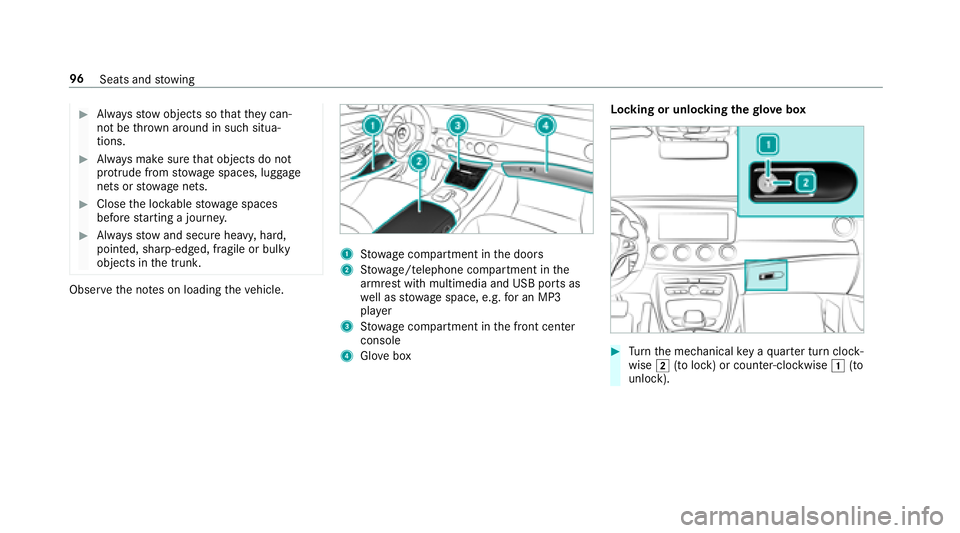
#Alwaysstow objects so that they can‐
not be throw n around in such situa‐
tions.
#Alw ays make sure that objects do not
pr otru de from stowage spaces, luggage
nets or stowage nets.
#Close the loc kable stow age spaces
before starting a journe y.
#Alwaysstow and secure heavy, hard,
pointe d, sharp-edged, fragile or bulky
objects in the trunk.
Obser vethe no tes on loading theve hicle.
1Stow age compartment in the doors
2St ow age/telephone compartment in the
armrest with multimedia and USB ports as
we ll as stow age space, e.g. for an MP3
pla yer
3Stow age compartment in the front center
console
4Glo vebox Locking or unlocking
thegl ove box#Turn the mechanical key a quarter turn clock‐
wise 2(to lock) or counter-clockwise 1(to
unlock).
96 Seats and stowing
Page 133 of 502
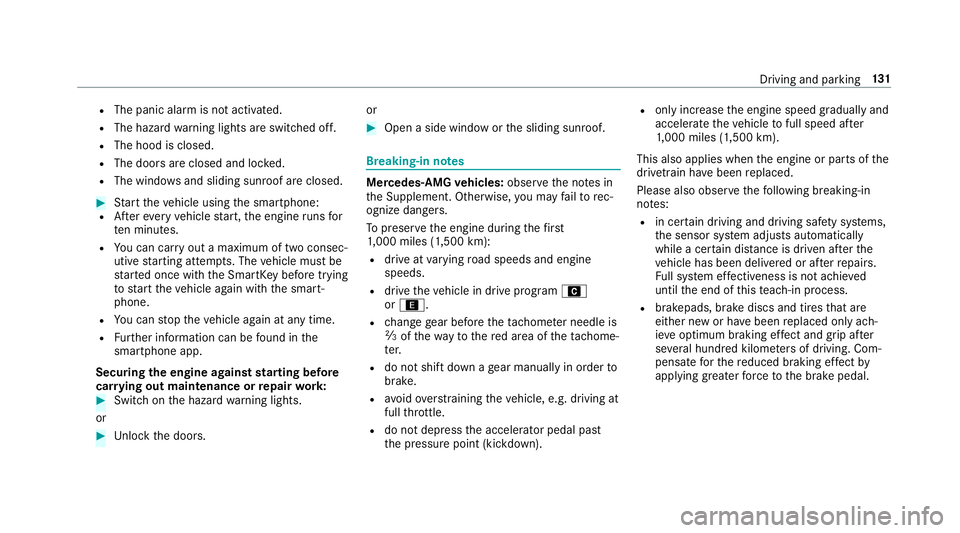
RThe panic alarm is not activated.
RThe hazardwarning lights are switched off.
RThe hood is closed.
RThe doors are closed and loc ked.
RThe windo wsand sliding sunro of are closed.
#Start theve hicle using the smartphone:RAf tereve ryvehicle start, the engine runs for
te n minu tes.
RYo u can car ryout a maximum of two consec‐
utive starting attem pts. The vehicle must be
st ar ted once with the SmartK eybefore trying
to start theve hicle again with the smart‐
phone.
RYo u can stop theve hicle again at any time.
RFu rther information can be found inthe
smartphone app.
Securing the engine against starting before
car rying out maintenance or repair work:
#Switch on the hazard warning lights.
or
#Un lock the doors. or
#Open a side window or
the sliding sunroof.
Breaking-in no tes
Mercedes-AMG vehicles: observeth e no tes in
th e Supplement. Otherwise, you may failto rec‐
ognize dangers.
To preser vethe engine during thefirs t
1, 000 miles (1,500 km):
Rdrive at varying road speeds and engine
speeds.
Rdrive theve hicle in drive program A
or ;.
Rchange gear before theta ch ome ter needle is
Ô ofthewa yto there d area of theta ch ome‐
te r.
Rdo not shift down a gear manually in order to
brake.
Ravo idoverstra ining theve hicle, e.g. driving at
full thro ttle.
Rdo not depress the accelera tor pedal past
th e pressure point (kickdown).
Ronly increase the engine speed gradually and
accelerate theve hicle tofull speed af ter
1, 000 miles (1,500 km).
This also applies when the engine or parts of the
driv etra in ha vebeen replaced.
Please also obser vethefo llowing breaking-in
no tes:
Rin cer tain driving and driving saf etysy stems,
th e sensor sy stem adjusts automatically
while a cer tain dis tance is driven af terth e
ve hicle has been delivered or af terre pairs.
Fu ll sy stem ef fectiveness is not achie ved
unt ilth e end of this teach-in process.
Rbrakepads, brake discs and tires that are
either new or ha vebeen replaced only ach‐
ie ve opt
imum braking ef fect and grip af ter
se veral hundred kilom eters of driving. Com‐
pensate forth ere duced braking ef fect by
applying greater forc eto the brake pedal.
Driving and parking 13
1
Page 150 of 502
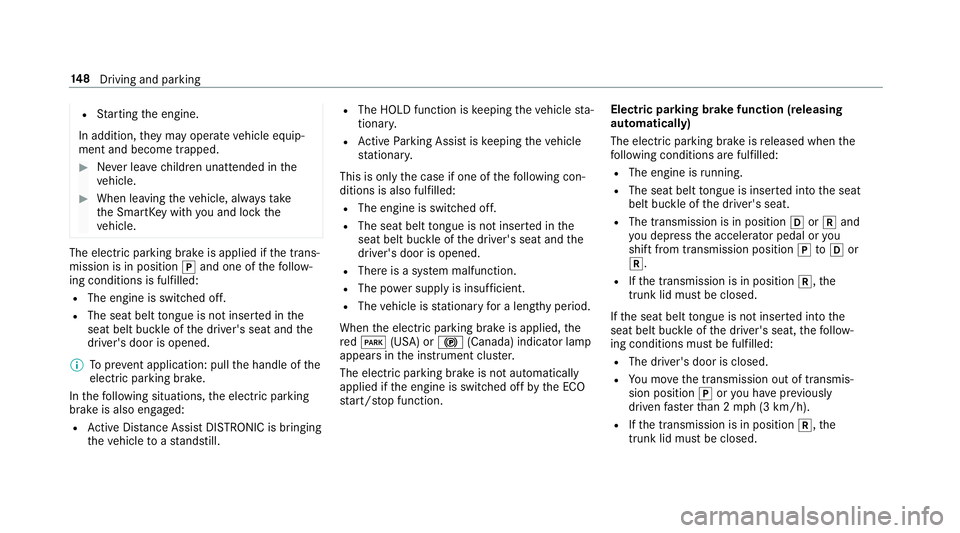
RStarting the engine.
In addition, they may operate vehicle equip‐
ment and become trapped.
#Ne ver lea vechildren unatte nded inthe
ve hicle.
#When leaving theve hicle, alw aysta ke
th e SmartK eywith you and lock the
ve hicle.
The electric parking brake is applied if the trans‐
mission is in position jand one of thefo llow‐
ing conditions is fulfilled:
RThe engine is switched off.
RThe seat belt tongue is not inser ted in the
seat belt buckle of the driver's seat and the
driver's door is opened.
% Toprev ent application: pull the handle of the
electric parking brake.
In thefo llowing situations, the electric parking
brake is also engaged:
RAc tive Dis tance Assist DISTRONIC is bringing
th eve hicle toast andstill.
RThe HOLD function is keeping theve hicle sta‐
tionar y.
RActive Parking Assist is keeping theve hicle
st ationar y.
This is only the case if one of thefo llowing con‐
ditions is also fulfilled:
RThe engine is switched off.
RThe seat belt tongue is not inser ted in the
seat belt buckle of the driver's seat and the
driver's door is opened.
RThere is a sy stem malfunction.
RThe po wer supply is insuf ficient.
RThe vehicle is stationary for a lengt hyperiod.
When the electric parking brake is applied, the
re dF (USA) or !(Canada) indicator lamp
appears in the instrument clus ter.
The electric parking brake is not automatically
applied if the engine is switched off bythe ECO
st art/ stop function. Electric parking brake function (releasing
automatically)
The electric parking brake is
released when the
fo llowin
g conditions are fulfilled:
RThe engine is running.
RThe seat belt tongue is inser ted into the seat
belt buckle of the driver's seat.
RThe transmission is in position hork and
yo u depress the accelera tor pedal or you
shift from transmission position jtoh or
k.
RIf th e transmission is in position k,the
trunk lid must be closed.
If th e seat belt tongue is not inser ted into the
seat belt buckle of the driver's seat, thefo llow‐
ing conditions must be fulfilled:
RThe driver's door is closed.
RYo u mo vethe transmission out of transmis‐
sion position joryou ha veprev iously
driven faster than 2 mph (3 km/h).
RIfth e transmission is in position k,the
trunk lid must be closed.
148
Driving and pa rking
Page 357 of 502
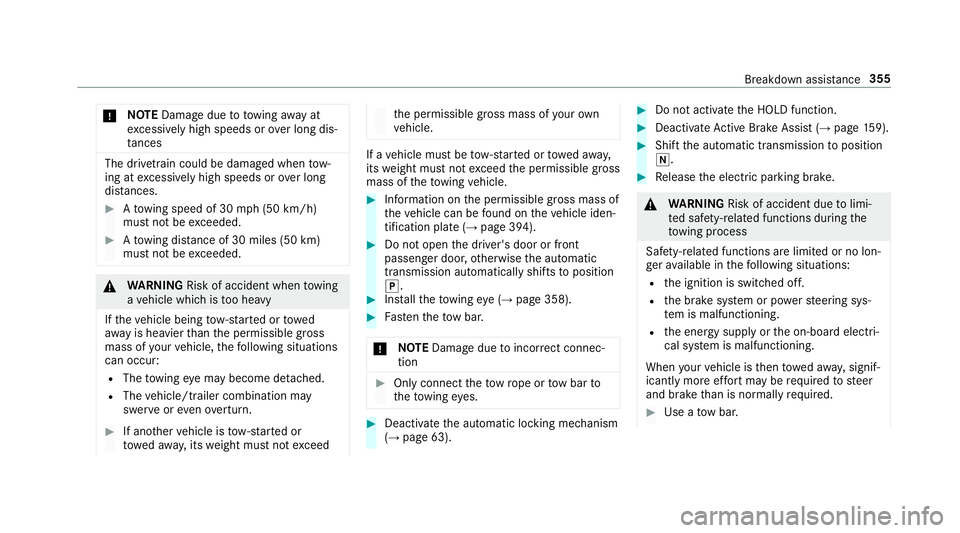
*NO
TEDama gedue to to wing away at
exc essively high speeds or over long dis‐
ta nces
The driv etra in could be damaged when tow‐
ing at excessively high speeds or over long
dis tances.
#A towing speed of 30 mph (50 km/h)
must not be exceeded.
#Atowing dis tance of 30 miles (50 km)
must not be exceeded.
&
WARNING Risk of accident when towing
a ve hicle which is too heavy
If th eve hicle being tow- star ted or towe d
aw ay is heavier than the permissible gross
mass of your vehicle, thefo llowing situations
can occur:
RThe towing eye may become de tach ed.
RThe vehicle/trailer combination may
swer veoreve nov erturn.
#If ano ther vehicle is tow- star ted or
to we daw ay, its weight must not exceed
the permissible gross mass of your ow n
ve hicle.
If a vehicle must be tow- star ted or towe daw ay,
its weight must not exceed the permissible gross
mass of theto wing vehicle.
#Information on the permissible gross mass of
th eve hicle can be found on theve hicle iden‐
tification plate (
→page 394).
#Do not open the driver's door or front
passenger door, otherwise the automatic
transmission automatically shifts toposition
j.
#Ins tallth eto wing eye (→page 358).
#Fa sten theto w bar.
* NO
TEDama gedue toincor rect connec‐
tion
#Only connect theto w rope or tow bar to
th eto wing eyes.
#Deactivate the automatic locking mechanism
(→page 63).
#Do not activate the HOLD function.
#Deactivate Active Brake Assi st(→page 159).
#Shift the automatic transmission toposition
i.
#Re lease the electric parking brake.
&
WARNING Risk of accident due tolimi‐
te d saf ety-re lated functions during the
to wing process
Saf ety-re lated functions are limited or no lon‐
ge rav ailable in thefo llowing situations:
Rth e ignition is switched off.
Rthe brake sy stem or po werst eering sys‐
te m is malfunctioning.
Rth e energy supply or the on-board electri‐
cal sy stem is malfunctioning.
When your vehicle is then towe daw ay, signif‐
icantly more ef fort may be requ ired tosteer
and brake than is no rmally requ ired.
#Use a tow bar.
Breakdown assis tance 355
Page 389 of 502
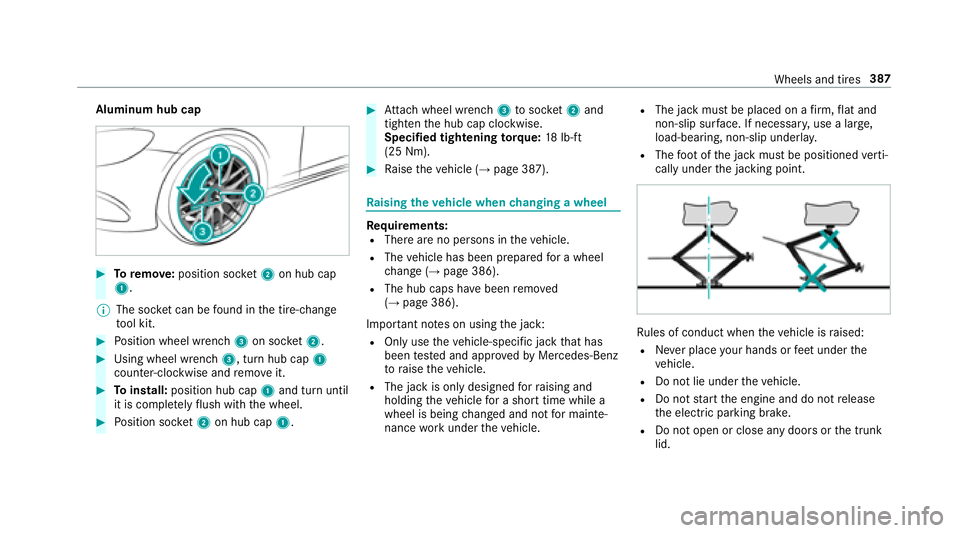
Aluminum hub cap
#Toremo ve:position soc ket2 on hub cap
1.
% The soc ket can be found inthe tire-change
to ol kit.
#Po sition wheel wrench 3on soc ket2.
#Using wheel wrench 3, turn hub cap1
counter-clo ckwise and remo veit.
#To install: position hub cap 1and turn until
it is comple tely flush withth e wheel.
#Po sition soc ket2 on hub cap 1.
#Attach wheel wrench 3tosoc ket2 and
tighten the hub cap clockwise.
Specified tightening torq ue: 18lb-ft
(25 Nm).
#Ra ise theve hicle (→page 387).
Ra ising theve hicle when changing a wheel
Re quirements:RThere are no persons in theve hicle.
RThe vehicle has been prepared for a wheel
ch ange (→page 386).
RThe hub caps ha vebeen remo ved
(→page 386).
Impor tant no tes on using the jack:
ROnly use theve hicle-specific jack that has
been tested and appr ovedby Mercedes-Benz
to raise theve hicle.
RThe jack is only designed forra ising and
holding theve hicle for a short time while a
wheel is being changed and not for mainte‐
nance workunder theve hicle.
RThe jack must be placed on a firm ,fl at and
non-slip sur face. If necessar y,use a lar ge,
load-bearing, non-slip underla y.
RThefoot ofthe jack must be positioned verti‐
cally under the jacking point.
Ru les of conduct when theve hicle is raised:
RNe ver place your hands or feet under the
ve hicle.
RDo not lie under theve hicle.
RDo not start the engine and do not release
th e electric parking brake.
RDo not open or close any doors or the trunk
lid.
Wheels and tires 387
Page 443 of 502
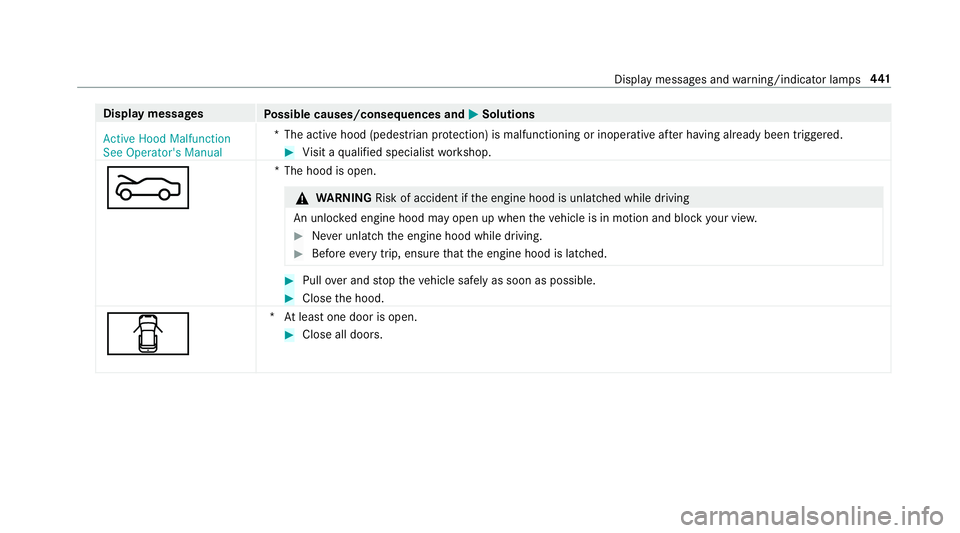
Displaymessages
Possible causes/consequences and MSolutions
Active Hood Malfunction
See Operator's Manual *T
he active hood (pedestrian pr otection) is malfunctioning or inoperative af ter having already been triggered.
#Vi sit a qualified specialist workshop.
M
*T he hood is open.
&
WARNING Risk of accident if the engine hood is unlatched while driving
An unloc ked engine hood may open up when theve hicle is in motion and block your vie w.
#Never unlatch the engine hood while driving.
#Before every trip, ensure that the engine hood is latched.
#Pull over and stop theve hicle safely as soon as possible.
#Close the hood.
C
*A t least one door is open.
#Close all doors.
Displ aymessage s andwarning/indicator lamps 44
1
Page 475 of 502
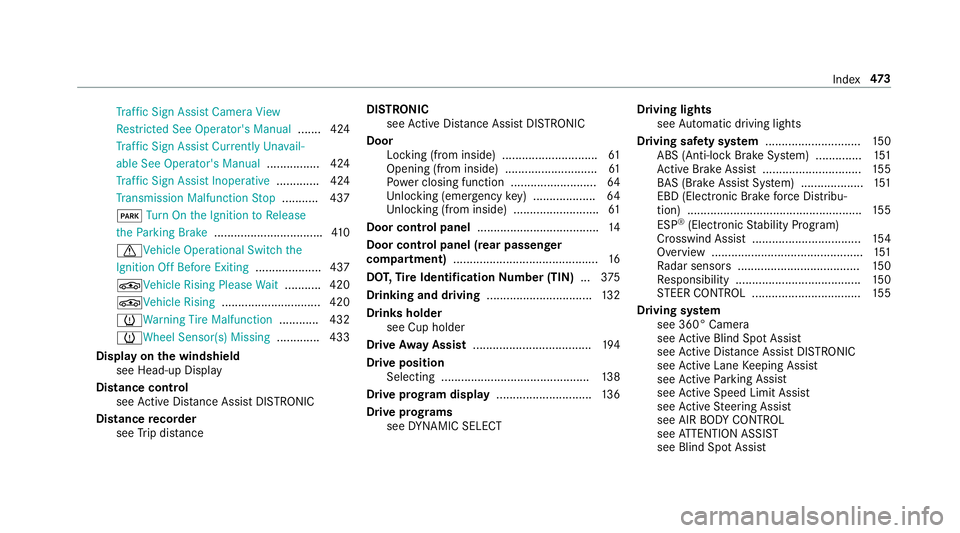
Traf fic Sign Assist CameraView
Re stricted See Ope rator's Manual .......424
Tr af fic Sign Assist Currently Unavail‐
able See Operator's Manual ................ 424
Tr af fic Sign Assist Inoperative............. 424
Tr ansmission Malfunction Stop ........... 437
F Turn On the Ignition to Release
th ePa rking Brake ................................ .410
dVe hicle Operational Switch the
Ignition Off Before Exiting .................... 437
ÉVe hicle Rising Please Wait.......... .420
ÉVe hicle Rising .............................. 420
hWa rning Tire Malfunction ............ 432
hWheel Sensor(s) Missing .............433
Display on the windshield
see Head-up Display
Distance control see Active Dis tance Assist DISTRONIC
Di stance recorder
see Trip dis tance DI
STRO NIC
see Active Dis tance Assist DISTRONIC
Door Locking (from inside) ............................. 61
Opening (from inside) ............................6 1
Po we r closing function ..........................6 4
Un locking (emer gency key) .................. .64
Un locking (from inside) .......................... 61
Door cont rol panel .................................... .14
Door cont rol panel (rear passenger
compartment) ........................................ ...
.
16
DO T,Tire Identification Number (TIN) ...375
Drinking and drivin g................................ 132
Drink sholder
see Cup holder
Driv eAwa y Assist .................................... 194
Driv eposition
Selecting ............................................ .138
Drive prog ram display ............................. 136
Driv eprog rams
see DYNA MIC SELECT Driving lights
see Automatic driving lights
Driving saf ety sy stem ............................ .150
ABS (Anti-lock Brake Sy stem) .............. 151
Ac tive Brake Assi st.............................. 155
BA S (Brake Assist System) .................. .151
EBD (Electronic Brake forc e Distribu‐
tion) ..................................................... 155
ESP
®(Electronic Stability Prog ram)
Crosswind Assist ................................. 154
Overview ..............................................1 51
Ra dar sensors .....................................1 50
Re sponsibility ...................................... 150
ST EER CONTROL ................................. 155
Drivin gsy stem
see 360° Camera
see Active Blind Spot Assi st
see Active Dis tance Assist DISTRONIC
see Active Lane Keeping Assist
see Active Parking A
ssist
see Active Speed Limit Assi st
see Active Steering Assist
see AIR BODY CONTROL
see ATTENTION ASSIST
see Blind Spot Assist
Index 47
3